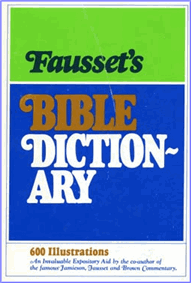Fausset's Bible Dictionary
A B C D E F G H I J K L M N O P Q R S T U V W X Y Z
Hart
ayal. The male of the stag, Cervus Duma. Resorting to the mountains (Song of Solomon 8:14); sure-footed there (2 Samuel 22:34; Habakkuk 3:19). Monogamous and constant in affection (Proverbs 5:19). In Psalm 42:1 the verb is feminine; the hind therefore, not the hart, is meant; her weakness intensifies her thirst. The emblem of activity (Isaiah 35:6). So Naphtali is described by Jacob prophetically (Genesis 49:21), "a hind let loose." His active energy was shown against Jabin the Canaanite oppressor (Judges 4:6-9; Judges 5:18). The Targums say he first told Jacob that Joseph was yet alive; "he giveth goodly words." The Hebrew sheluchim, "the apostles," answers to shelucha "let loose." So the prophecy hints at what Isaiah (Isaiah 52:7) more clearly unfolds, "how beautiful upon the mountains are the feet of him that bringeth good tidings."
Easily agitated (Song of Solomon 2:7; Song of Solomon 3:5), so that the hunter must advance on them with breathless caution if he would take them; an emblem of the resting (Zephaniah 3:17) but easily grieved Holy Spirit (Ezekiel 16:43; Matthew 18:7; Ephesians 4:30). The thunder so terrifies them that they prematurely bring forth (Psalm 29:9). The case of their parturition, through the instinct given them by God's care, stands in contrast to the shepherd's anxiety in numbering the months of the flock's pregnancy, and is an argument to convince Job (Job 39:1-3) of God's consummate wisdom; why then should he harbour for a moment the thought that God, who cares so providentially for the humblest creature, could be capable of harshness and injustice toward His noblest creature, man?
The masculine ayal, Septuagint elafos, is the fallow deer (Dama commonis) or the Barbary deer (Cervus Barbarus) according to Appendix, Smith's Bible Dictionary Timid and fleet especially when seeking and not able to find pasture (Lamentations 1:6); emblem of Zion's captive princes at Babylon. Septuagint and Vulgate read eylim, "rams." Ajalon abounded in the ayal, whence it took its name. Aijeleth, "the hind," in the title Psalm 22 symbolizes one shot at by the archers and persecuted to death, namely, Messiah; as the persecutors are symbolized by "bulls," "lions," "dogs."
The addition "of the morning" (shahar) implies prosperity dawning after suffering. The hind is emblematic of the grace, innocence, and loveliness (Song of Solomon 2:9) of the Antitype to Joseph (Genesis 49:23-24). The hind's sure footing in the rocks typifies the believer's preservation in high places and difficulties. The Arabs call a deer by a like name to the Hebrew, (iyal). The deer is represented on the slabs at Nineveh, and seems to have abounded anciently in Syria, though not there now.
Bibliography Information
Fausset, Andrew Robert M.A., D.D., "Definition for 'hart' Fausset's Bible Dictionary".
bible-history.com - Fausset's; 1878.
Copyright Information
© Fausset's Bible Dictionary
Fausset's Bible Dictionary Home
Bible History Online Home
Bible Encyclopedia (ISBE)
Online Bible (KJV)
Naves Topical Bible
Smith's Bible Dictionary
Easton's Bible Dictionary
Schaff's Bible Dictionary
Fausset's Bible Dictionary
Matthew Henry Bible Commentary
Hitchcock's Bible Dictionary

Dr. A.R. Fausset
Popular and Trending:
Meaning and definition of fasting, what is fasting in the bible, fasting definition, why should I fast, the power of prayer and fasting, Location of Galilee, where was galilee in the bible?, fasting definition, Galilee region, cities of Galilee, Sea of Galilee, Definition of biblical fire, what is fire in the bible?, fire and brimstone, fire meaning, baking bread with fire, Definition of the biblical firmament in Genesis, what is the firmament in the bible?, was the firmament the third heaven, firmament meaning, did the firmament bring the flood of Noah?.
